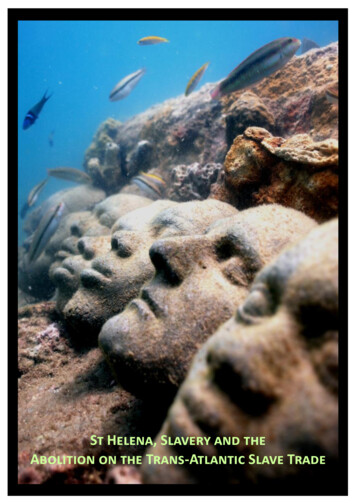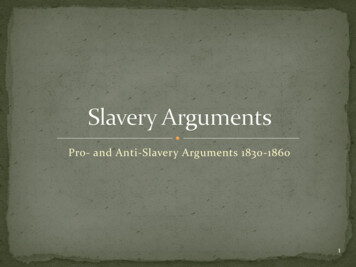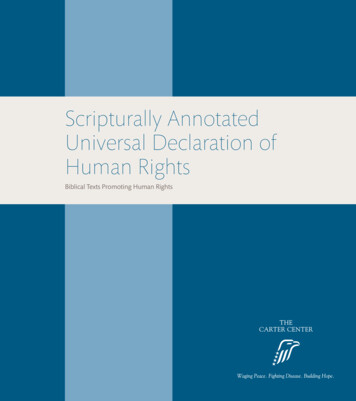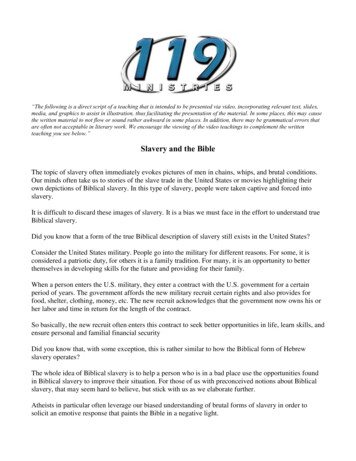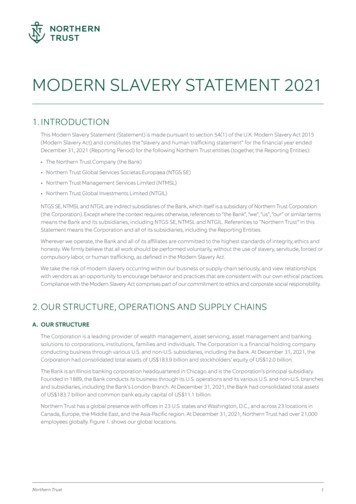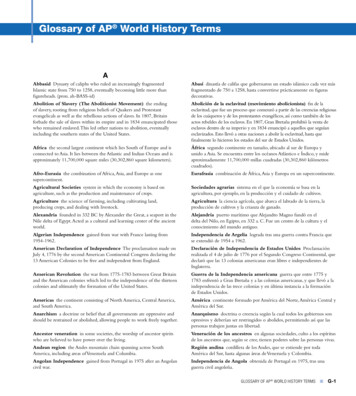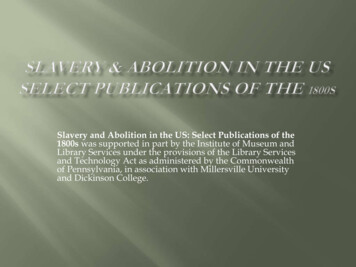
Transcription
Slavery and Abolition in the US: Select Publications of the1800s was supported in part by the Institute of Museum andLibrary Services under the provisions of the Library Servicesand Technology Act as administered by the Commonwealthof Pennsylvania, in association with Millersville Universityand Dickinson College.
Slavery and Abolition in the US: Select Publications of the 1800s is a digital collection ofbooks and pamphlets that demonstrate the varying ideas and beliefs about slavery in theUnited States as expressed by Americans throughout the nineteenth century. The worksin this collection reflect arguments on both sides of the slavery debate and include firstperson narratives, legal proceedings and decisions, anti-slavery tracts, religious sermons,and early secondary works. The publications are all drawn from the holdings of theMillersville University Library and the Dickinson College Library, as well as each of theirrespective Special Collections Departments. The collection includes more than 24,000individual pages of printed text and corresponding searchable transcriptions. This onlineresource is made freely available to the public, and we hope that providing these rare andimportant research materials will enhance teaching and learning, at all levels ofinstruction, about this complex issue.
Lewis Tappan and William Lloyd Garrisonfounded the American Anti-SlaverySociety in 1833. The society gave formerslaves such as Frederick Douglass andWilliam Wells Brown a chance to tell theirstories. The society was very popular andspread to 1,350 local chapters with nearly250,000 members. To further their cause,theAmericanAnti-Slaverysocietypublished a newspaper called the NationalAnti-Slavery. Many famous abolitionistsbelonged to the American Anti-SlaverySociety. Even though the Society wasquite popular in certain circles, it often metharsh resistance for its beliefs andpractices.A formal statement of the beliefs and goalsof the American Anti-Slavery Society atthe time of their founding.American Anti-Slavery Society. Declarationof Sentiments of the American Anti-SlaverySociety. Adopted at the Formation of saidSociety, in Philadelphia, on the 4th Day ofDecember, 1833. New York: The Society,c1844.
During this convention, the delegatesdiscussed how to end the slave tradeas well as how to end slavery in stateslike Connecticut.American Convention for Promoting the Abolitionof Slavery, and Improving the Condition of theAfrican Race. Minutes of the Proceedings of the SecondConvention of Delegates from the Abolition SocietiesEstablished in Different Parts of the UnitedStates: Assembled at Philadelphia, on the Seventh Day ofJanuary, One Thousand Seven Hundred and NinetyFive. Philadelphia: Zachariah Poulson, Jr., 1795.
Born into a Quaker family on May 7, 1799, inElizabethtown, PA, Edwin Pitt Atlee moved toPhiladelphia with his family at the age ofeight. As a child he was tutored by BenjaminTucker, an active member of the anti-slaverysociety. Atlee went on to study medicine at theUniversity of Pennsylvania.He joined thePennsylvania Anti-Slavery society in 1821. Atleewas also a Pennsylvania delegate to the AmericanConvention for the Abolition of Slavery. Heserved as president for schools under thedirection of the society for several years. EdwinAtlee died on December 25, 1836.Atlee, Edwin Pitt. Address Delivered before theFemale Anti-slavery Society of Philadelphia, inthe Session Room of the Second PresbyterianChurch (on Cherry Street,) in the First Month,(January,) 1834. Philadelphia: T.K. Collins &Company, 1834.In his address, Edwin Atlee discusses thesuffering of slaves including the enslavement ofchildren based on the status of the mother.
Benjamin Bacon providesinformation on the educationand employment of AfricanAmericans in Philadelphia inthe 1850s.Bacon, Benjamin C. Statistics oftheColoredPeopleofPhiladelphia. Philadelphia: T.Ellwood Chapman, 1856.
Frederick Douglass was born in February 1818, as a slave in TalbotCounty, Maryland. At the age of twelve, his master’s wife began toteach him the alphabet, but was ordered to stop by her husband.Despite this interference, Douglass learned to read from whitechildren and to write from watching writings of the men he workedwith. Once literate, Douglass read newspapers, books and anymaterial he could find. Also, he taught many other slaves to read theNew Testament at Sabbath school.On September 3, 1838, Douglass escaped from the plantation bytrain, traveled to New York and eventually to Massachusetts. A yearbefore Douglass obtained freedom he met Anna Murray, a freeAfrican American, who he married after his escape. Douglass isremembered for his work as an abolitionist, author and politician.He published several newspapers that focused on key social issueslike the education of African Americans. In 1872, Douglass wasnominated as Victoria Woodhull’s running mate on the Equal RightsParty ticket. This made him the first African American to benominated for the office of Vice President of the United States.Frederick Douglass died on February 20, 1895.
Frederick Douglassrecountshispersonal experiencesas a slave.Frederick Douglass offersanautobiographicalaccount of his life bothas a slave and later as afree man.Douglass, Frederick. Narrative ofthe Life of Frederick Douglass, anAmerican Slave. Boston: Publishedat the Anti-Slavery Office, 1845.Douglass, Frederick. My BondageandMyFreedom.NewYork: Miller, Orton & Mulligan,1855.
Written nearly fifty years later, DavidForbes recounts the events surroundingthe Christiana Riot in Pennsylvania.Forbes, David R. A True Story of theChristiana Riot. Quarryville, PA: SunPrinting House, 1898.
Born in Massachusetts on December 12, 1805, WilliamLloyd Garrison became a prominent social reformer. Inhis twenties, Garrison supported colonization for thefreed slaves but soon rejected these plans, in favor ofabolition. He was editor of the abolitionist newspaperThe Liberator. Garrison was also a founder of theAmerican Anti-Slavery Society. He originally advocatedfor gradual emancipation but started to fight forimmediate and universal abolition of slavery. Garrisonshook the abolitionist movement when he allowedwomen to participate in the American Anti-SlaverySociety. Garrison became extremely unpopular incertain circles after he declared the United StatesConstitution a pro-slavery document that should beburnt. After the abolition of slavery, Garrison continuedto work for social reforms including women’s rights andtemperance. Garrison died on May 24, 1879 and wasburied in Massachusetts.Arguing that free African Americans are denied basichuman rights, William Lloyd Garrison outlines waysthat the community can overcome the differences in theraces.Garrison, William Lloyd.An Address,Delivered Before the Free People of Color, inPhiladelphia, New-York, and Other Citiesduring the Month of June, 1831. Boston:Stephen Foster, 1831.
Ellwood Griest tells the story of twofugitive slaves that made their way tofreedom with the assistance of the Quakersin Lancaster County, Pennsylvania.Griest, Ellwood. John and Mary; or, TheFugitive Slaves. A Tale of South-EasternPennsylvania.Lancaster, PA: InquirerPrinting and Publish Company, 1873.
Hinton Rowan Helper was born on December 27, 1829in Mocksville, North Carolina. He graduated fromMocksville Academy in 1848. In 1851, Helper moved toCalifornia but was unsuccessful in becoming wealthyand eventually moved back to North Carolina. Helperpublished The Impending Crisis of the South in 1857. Thebook used statistical facts to prove that slavery was notonly harmful to the economic stability of nonslaveholders but also destructive for the south as awhole. Helper’s book was banned in the south, but wasused as a campaign document by the Republican Partyfrom 1857 until 1861. Even though Helper did notbelieve in slavery, he was not a friend to the AfricanAmericans living in the country. He believed that theraces should be kept separate at all costs. HintonRowan Helper died on March 8, 1909.Hinton Helper, a Southerner, suggests that slavery isleading to the economic downfall of the South and thatabolition is necessary in order to become commerciallycompetitive.Helper, Hinton Rowan.TheImpending Crisis of the South: How toMeet It.New York: BurdickBrothers, 1857.
Benjamin Lundy was born on January 4, 1789 in Hardwick,New Jersey. Lundy was a member of the Religious Societyof Friends. At the age of nineteen, moved to Wheeling,Vermont, where he served an apprenticeship with a saddlemaker. This is where he first became opposed to the slavetrade. 1815 he founded the Union Human Society. Thefollowing year, Lundy established the anti-slaverynewspaper Genius of Universal Emancipation.William Lloyd Garrison aided Lundy with the publicationof the newspaper until Garrison moved to Boston. Lundyeventually moved to Philadelphia and began thenewspaper, The National Inquirer, in 1829. Many of Lundy’sbelongings were lost in the burning of the PennsylvaniaHall in 1838 by a mob. In 1839, he moved to Illinois andreturned to publishing Genius of Universal Emancipation.Lundy traveled throughout the country and its territories inattempts to limit the spread of slavery. Benjamin Lundydied on August 22, 1839.Thomas Earle recounts the life of Benjamin Lundy, an activeabolitionist who traveled about the young United States andthe western territories.Lundy, Benjamin. The Life, Travels, andOpinions of Benjamin Lundy, Including hisJourneys to Texas and Mexico, with a Sketch ofContemporary Events, and a Notice of theRevolution in Hayti. Philadelphia: W.D.Parrish, 1847.
Lucretia Mott was born on January 3, 1793, in Nantucket,Massachusetts, as Lucretia Coffin. In 1811, she married JamesMott, an abolitionist and woman’s rights supporter, whoactively supported his wife’s endeavors. Born into a family ofQuakers, she became a minister in 1821. She was an activeabolitionist and aided in the foundation of two anti-slaverygroups. In her fight against slavery, Lucretia Mott boycottedthe by-products of slavery. Mott is best remembered for theclarity and power of her speeches.After Mott was refused a seat at the 1840 World Anti-SlaveryConvention, Mott became and tireless advocate of women’srights and worked with Elizabeth Cady Stanton inorganizing the Seneca Falls Convention in New York. In1850, Mott published Discourse on Women, which detailed therestrictions placed on women in the United States andWestern Europe. Lucretia Mott died on November 11, 1880.Mott, Lucretia. A Sermon to the MedicalStudents, Delivered by Lucretia Mott, atCherry Street Meeting House, Philadelphia,on First-Day Evening, Second Month 11th,1849.Philadelphia: Merrihew &Thompson, 1849.In this sermon, Lucretia Mott discusses the evils of slaveryand the importance of education for people of all races.
James and Lucretia Mott created the Pennsylvania a. In 1838, the Pennsylvania Anti-SlaverySociety built Pennsylvania Hall. Pro-slavery riotersburned the building three days after it opened. Severalprominent abolitionists such as Mary Grew, JamesMiller McKim, and Robert Purvis served as members ofthe society. While working at the society, William Still,helped a man named Peter Freedman, who he laterdiscovered was his own brother.
The Pennsylvania Anti-Slavery Society issues theannual report of its activities, and includesreports on recent events in Christiana.Pennsylvania Anti-Slavery Society.Fourteenth AnnualReport, Presented to the Pennsylvania Anti-Slavery Society, byIts Executive Committee, October 7, 1851: with the Proceedingsof the Annual Meeting. Philadelphia: Anti-Slavery Office;Merrihew & Thompson, Printers, 1851.In telling the story of Passmore nsylvanians against the power of the FederalGovernment.Pennsylvania Anti-Slavery Society. Narrative of the Factsin the Case of Passmore Williamson.Philadelphia:Merrihew & Thompson, 1855.
Durbin was born in Kentucky, Durbin became a cabinetmaker apprentice at the age 13 following his father’sdeath. Durbin continued to educate himself, eventuallybecoming a licensed minister. His travels led him toOhio where he was able to attend college. Aftergraduating, he taught at Augusta College in Kentuckyand became Chaplain for the United States Senate. JohnPrice Durbin served as president of Dickinson Collegefrom 1834 until 1842 when he returned to the ministry.He died on October 18, 1876.No information is available for William Pettit.Pettit, William V., and John P.Durbin. Addresses Delivered in the Hall ofthe House of Representatives, Harrisburg,PA. On Tuesday Evening, April 6,1852.Philadelphia: PennsylvaniaColonization Society, 1852.Both William Pettit and John Price Durbin argue thatslavery is an evil that should be ended, but they alsosuggest that America cannot handle the emancipation ofthe freed slaves financially, and that the best solution iscolonization.
James Redpath was born in England on August 24, 1833. In1849, Redpath immigrated with his family to Michigan. Once inAmerica, Redpath entered the printer’s trade and wrote for theanti-slavery movement under the name “Berwick.” Discoveredby Horace Greeley, Redpath moved to New York to work onThe New York Tribune at the age of 19. Redpath made severaltrips into the South to study the institution of slavery firsthand. From these trips, Redpath published The Roving Editor, or,Talks with Slaves in the Southern United States. In 1855, hetraveled to Kansas and became actively involved with the antislavery movement taking place in the territory. While inKansas, Redpath met John Brown with whom he shared similarideology about slavery. During the Civil War, he continued topublish and write materials. In 1879, James Redpath startedreporting on the tumultuous happenings of Ireland. He servedas an editor for the book Jefferson Davis, ex-president of theConfederate States of America: a memoir by his wife. Due to injuriessustained after being hit by a vehicle while crossing the street,James Redpath died on February 10, 1891.In this biography published shortly after the execution of JohnBrown, James Redpath recounts the life of the leader of thefamed Harpers Ferry raid.Redpath, James. The Public Life ofCapt. John Brown. Boston: Thayerand Elderidge, 1860.
James J. Robbins, workingfrom the notes of courtreporters Arthur Cannonand Samuel Dalrymple,recounts the trial ofCastner Hanway, whostood accused for hisinvolvementintheChristiana Riot.Robbins, James J. Report of theTrial of Castner Hanway forTreason, in the Resistance of theExecution of the Fugitive Slave Lawof September, 1850. Philadelphia:King and Baird, 1852.
Franklin Benjamin Sanborn was born in New Hampshire onDecember 15, 1831. Sanborn attended Harvard, graduating inthe class of 1855. After college, he settled in Concord,Massachusetts. Sanborn was one of John Brown’s secret six,influential financial supporters of Brown’s movement. AfterBrown’s attack Sanborn fled to Canada with two othermembers of the group. The United States Senate attemptedto get him to testify but he remained on the run until thestateofMassachusettssteppedintoprotecthim. Throughout his life, Sanborn worked as a journalist andadvocate for social reforms, including prison reform andtreatment of the mentally ill. Sanborn died on February 24,1917, in New Jersey.Journalist Franklin B. Sanborn offers a biographical accountof his friend John Brown, and includes in his workcorrespondence between Brown and other prominent figuresof his time.Sanborn, Franklin B. The Life and Letters ofJohn Brown, Liberator of Kansas, and Martyr ofVirginia. Boston: Roberts Brothers, 1885.
Born in Vermont on April 4, 1792, Thaddeus Stevens suffered many hardshipsas a child including being born with a club foot and having an alcoholicfather. Stevens graduated from Dartmouth in 1814 and moved to York,Pennsylvania, where he taught and studied law. After passing the bar,Stevens practiced law in Gettysburg and then in Lancaster. Thaddeus Stevenswas an active member of political parties including the Federalist Party, theAnti-Masonic Party, the Whig Party, and the Republican Party. He was amember of the House of Representatives from 1849-1853, and again from 1859until his death in 1868. An active social reformer, Stevens increasingly becameinvolved in defending fugitive slaves. Stevens died on August 11, 1868, inWashington, D.C. His funeral and burial took place in Lancaster, PA. In hiswill, Thaddeus Stevens left money for the development of a school fororphaned children regardless of color.
Senator Thaddeus Stevens argues against theexpansion of slavery into the western territories.Thaddeus Stevens suggests thatthe majority of the nationopposes slavery, but that theinstitution has grown inimportance, replacing othernotableissuessuchasagriculture and commerce.Stevens, Thaddeus. Speech of Hon. Thaddeus Stevens, ofPennsylvania, in the U.S. House of Representatives, Wednesday,Feb. 20, 1850, in the Committee of the Whole State of the Union, onthe Reference of the President’s Annual Message. Philadelphia:Anti-Slavery Office, 1850.Stevens, Thaddeus. Speech of Hon. Thaddeus Stevens, ofPenn., on the Presidential Question; and the SlaveryIssue: Delivered in the House of Representatives, August12 1852. Washington, DC: Congressional Globe Office,1852.
Jesse Torrey was a physician in Philadelphia. Hewrote A Portraiture of Domestic Slavery in the UnitedStates based on his observations and interviewsabout the slave trade. Torrey was the author ofseveral other works including The American SlaveTrade, Or An Account Of The Manner In Which TheSlave Dealers Take Free People From Some Of TheUnited States Of America, And Carry Them Away, AndSell Them As Slaves In Other Of The States. e other reformers of the timeadvocated for colonization, Torrey believed thatmost slaves would like to remain in America wherethey were born.Writing for an end to the African slave-trade, JesseTorrey argues that, while slavery might continue inthe United States, slave masters should not betyrants to those under their authority.Torrey, Jesse. Portraiture of Domestic Slavery, in the United States: With Reflections on the Practicability of Restoring the MoralRights of the Slave, without Impairing the Legal Privileges of the Possessor; And a Project of a Colonial Asylum for Free Persons ofColour: Including Memoirs of Facts on the Interior Traffic in Slaves, and on Kidnapping. Philadelphia: Published by the author.John Bioren, printer, 1817.
Dudley Atkins Tyng was born on January 12,1825, in Prince George’s County, Maryland. Hegraduated from the University of Pennsylvania in1843, and then pursued studies in theology at theAlexandria seminary in Virginia. Tyng becamean Episcopal minister in 1846, and went on toserve in New York, Ohio, Pennsylvania, andVirginia. Tyng served as rector of the Church ofthe Epiphany in Philadelphia from 1854 untilright before his death. He was forced to leave hisparish over his opposition to slavery. He died asa result of an accident on April 19, 1858, inBrookfield, Pennsylvania.Reverend Dudley Tyng used the events in Kansasin 1854 to highlight the evils of slavery and theireffect on society.Tyng, Dudley Atkins. Our Country’sTroubles: A Sermon, Preached in the Churchof the Epiphany, Philadelphia, on SundayEvening, June 29, 1856., 1856.
Pennsylvania citizens expresstheir disgust and dismay thatslavery is tolerated in the nation’scapital.U.S. House of Representatives. Memorial ofCitizens of the State of Pennsylvania, Prayingfor the Enactment of a Law, that All ColoredChildren Born in the Dist. Of Columbia, after aCertain Day, Shall Be Free. Washington, DC:Gales & Seaton, 1828.
Webb, Samuel.History ofPennsylvania Hall, which wasDestroyed by a Mob, on the 17thof May, 1838. Philadelphia:Merrihew and Gunn, 1838.Attributed to Samuel Webb, thishistoryincludesletters,speeches and other informationregarding Pennsylvania Hall,built as a place to discussslavery and other importantsocial issues of the day, butdestroyed by an angry mobafter only four days.
Theodore Dwight Weld was born on November 23, 1803, inHampton, CT. Weld attended Philips Andover Academybut did not finish due to failing eyesight. In his youth, Weldwas influenced by Charles G. Finney and Charles Stuart. In1833, Weld began attending Lane Theological Seminary inOhio but left when the school’s trustees suppressed the antislavery movement on campus. In 1838, Theodore Weldmarried Angelina Emily Grimké. Weld was very active inthe anti-slavery movement on a national level. Not onlywas he a well known speaker, Weld was the editor of . Theodore Weld started a school for children of allraces and genders in Eagleswood, New Jersey, in 1854.Theodore Weld eventually moved to Massachusetts in 1864where he continued his work as a teacher andlecturer. Weld died on February 3, 1895.Weld, Theodore D.AmericanSlavery As It Is: Testimony of aThousand Witnesses. New York: TheAmerican Anti-Slavery Society,1839.Abolitionist Theodore Weld, with the assistance of theAmerican Anti-Slavery Society, publishes a compendium ofslavery accounts drawn primarily from newspapers andother printed sources.
Passmore Williamson was born on February 23, 1822, in Westtown,Pennsylvania. Williamson was a member of the Society of Friendsand believed strongly in the abolitionist movement. He served assecretary for the Pennsylvania Anti-Slavery Society. The actions ofPassmore Williamson gained notoriety in July 1855 whenWilliamson and William Still boarded a ship in Camden to removethe slave Jane Johnson and her children from John Wheeler’spossession. Wheeler’s political connections meant a speedy arrestfor Williamson.He was imprisoned in Philadelphia’sMoyamensing Prison. Presiding Judge Kane convicted PassmoreWilliamson of Contempt of Court. He served time from July 27 toNovember 3, 1855. The case highlighted the ongoing battle inAmerica between the abolitionist movement and the rights of theslaveholders. During his time in Moyamensing Prison, manyfamous abolitionists visited him in prison. Passmore Williamsondied in February of 1895.The trial of Passmore Williamson, accused of aiding fugitive slaves,is presented in full.Williamson, Passmore. Case of Passmore Williamson. Report of the proceedings on the Writ of Habeas Corpus, Issued by the Hon.John K. Kane, Judge of the District Court of the United States for the Eastern District of Pennsylvania, in the Case of the UnitedStates of America ex rel. John H. Wheeler vs. Passmore Williamson, Including the Several Opinions Delivered, and the Arguments ofCounsel, Reported by Arthur Cannon, Esq., Phonographer. Philadelphia: Uriah Hunt & Son, 1856.
Slavery and Abolition in the US: Select Publications of the 1800swas supported in part by the Institute of Museum and LibraryServices under the provisions of the Library Services andTechnology Act as administered by the Commonwealth ofPennsylvania, in association with Millersville University andDickinson College.To see all the materials in this digital collection, go index.html
In telling the story of Passmore Williamson's trial, the Anti-Slavery Society warns Pennsylvanians against the power of the Federal Government. Pennsylvania Anti-Slavery Society. Narrative of the Facts in the Case of Passmore Williamson. Philadelphia: Merrihew & Thompson, 1855.


